by Editor | Jan 30, 2012 | Accomodations, New Articles
Article and photos by Josette King
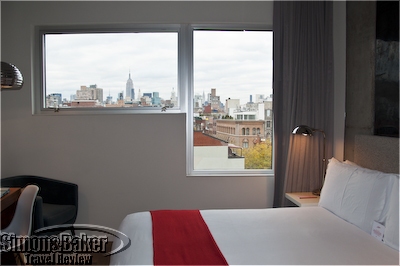
My room offered a sweeping view of the Manhattan skyline
When visiting New York City, I have a special fondness for Lower Manhattan, the southernmost and oldest part of the city. Although the area has gradually become gentrified in recent decades, the original ethnic neighborhoods have endured (think China Town and Little Italy). And within them new ones have emerged, such as SoHo (SOuth of HOuston Street), NoHo (NOrth of HOuston Street), TriBeCa (TRIangle BElow CAnal Street); and my new favorite, Nolita (NOrth of Little ITAly). Once considered part of Little Italy, Nolita has retained its lived-in cosmopolitan atmosphere and human scale. Here, traditional wrought-iron fire escapes still run down the façades of century-old brick apartment buildings. But old-time bakeries and utilitarian warehouses now mix with trendy shops and restaurants, and most recently, the newly opened The Nolitan Hotel.

The Empire State Building dominated the view from my room
In a town where boutique hotels often emerge from old buildings, The Nolitan grew from the ground up on what was a parking lot at the corner of Kenmare and Elizabeth streets. I loved the low-key luxury and laidback atmosphere of its light-filled lobby and lounge. With its plate glass façade and open plan, it was an inviting spot to linger and enjoy the dynamic street scene unfolding outside. My upper floor room was equally welcoming. The custom-designed contemporary furnishings and minimalist décor made for a comfortable urban retreat that was just the right setting for the jaw-dropping view. The panoramic perspective reached across the neighborhood rooftops, all the way to the Midtown Manhattan skyline dominated by the towering Empire State Building and the Art Deco spire of the Chrysler Building.
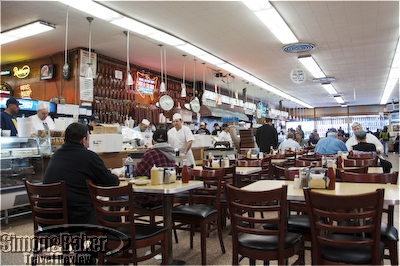
Katz Delicatessen
The Nolitan was ideally located to offer an easy all-around Manhattan experience. It was just a few minutes’ walk from the colorful chaos of Chinatown, the hip downtown shopping of SoHo and the popular delis of the Lower East Side (Katz’s Delicatessen of When Harry met Sally fame was a few blocks away on Houston Street). And when I felt like joining the Midtown crowds for a look at the famed Rockefeller Center Christmas tree (I visited in early December), or catch a Broadway show, a quick, direct subway ride whisked me there, and back home to the Nolitan faster than I could have hailed a cab. Visit the Simon & Baker Travel Review to read more about my stay at The Nolitan Hotel.
by Editor | Jan 23, 2012 | Attractions, New Articles
Article and photos by Elena del Valle
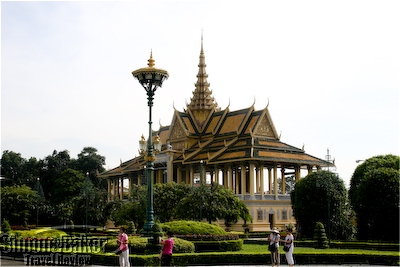
Part of the Royal Palace in Phnom Penh
When I visited Cambodia the last time I much enjoyed seeing Phnom Penh and Siem Reap and their salient tourist features in the company of an English speaking private guide. In Phnom Penh, my guide escorted me to Wat Phnom, a hill temple, the Royal Palace and Silver Pagoda, the National Museum, the Killing fields, the Toul Sleng Genocide Museum and one of the city markets. My tours and activities were organized by or held at the Raffles Hotel Le Royal in Phnom Penh and the Raffles Grand Hotel D’Angkor in Siem Reap where I stayed while in Cambodia. I was especially pleased that everyone was punctual and courteous without exception.
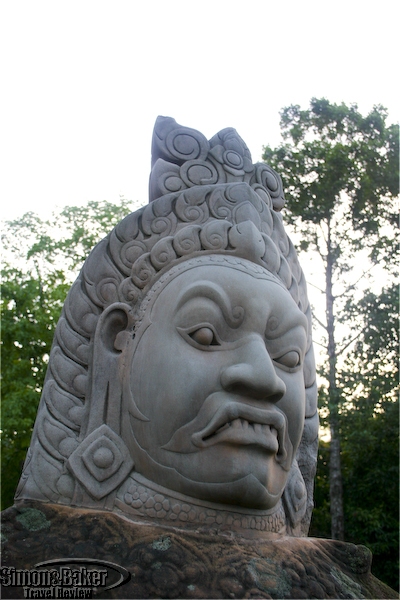
One of the many exceptional statues at the Angkor Wat temples near Siem Reap
In Siem Reap, where I had more time, the hotel proposed a variety of activities in house and within the city. At the hotel, I attended a cocktail tasting, tea with a hotel historian, a palm tree demonstration, a wine tasting at Le Grand Wine Cellar with the sommelier and hotel manager, a lotus plant demonstration, a private sunrise visit to Angkor Wat by jeep, a buffet dinner and Apsara Dance Performance, and a visit to Phra Ong Check Phra Ong Chom temple with Mouth Saravann, resident services manager and butler of the hotel.
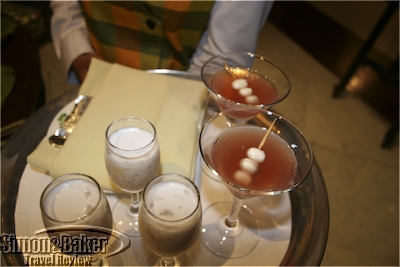
Lotus flower based drink demonstration and tasting
In addition, I attended a private Khmer cooking class including a visit to the Siem Reap market with Samreth Thai, junior sous chef of the hotel and my cooking instructor that day. Maing Meng Seap, the pastry chef, joined us for the important (for me) dessert course of the cooking class.
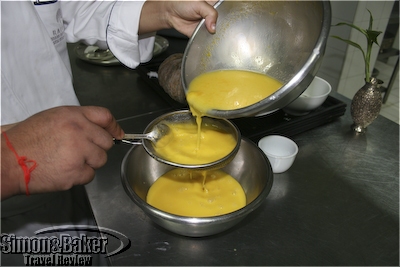
A demonstration during the cooking class
Following the cooking class, I had the pleasure of enjoying the meal we learned about in class, prepared by the hotel staff, in the hotel restaurant. And, to help me recover from all the excitement I indulged in a few spa treatments at the hotel’s Amrita Spa.
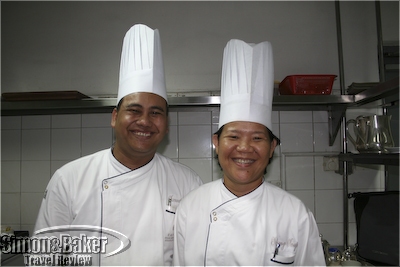
Samreth Thai, junior sous chef, and Maing Meng Seap, the pastry chef, at the Raffles Grand Hotel d’Angkor

Royal Khmer Cuisine book I received at the cooking class
One night, after a wine tasting at the hotel’s cozy “cellar” I enjoyed a cultural performance and dinner at the Raffles Grand Hotel d’Angkor in Siem Reap. The buffet dinner and performance offered copious quantifies of food, a variety of dishes and a live Khmer traditional dance performance. While I liked the food what I enjoyed the most was the performance. A group of young Khmer dancers performed six distinct pieces reflective of the traditions and fables of several regions: Ladies Bouquet, Coconut Shells Dance, Golden Mermaid (Part of the Ramayana), Tea Harvest Dance, Bokator (the Angkorean Martial Art), and Apsara Dance.
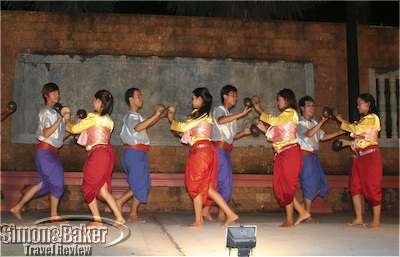
Apsara dance performance at the Raffles in Siem Reap
by Editor | Jan 16, 2012 | Products
By Gary Cox

ATT Elevate 4G
We like to stay connected when we travel. Our latest gadget in this quest is the new ATT Elevate 4G, a portable WiFi hot-spot that allows up to five devices to share a single data service connection. Traveling with a laptop, iPad, Kindle and Skype phone can be a challenge even with today’s ubiquitous WiFi network access, but the Elevate can make connecting simple. The access speed on a 4G network was great, making Skype calls clear and cellphone and web browsing very usable. Enabling the Elevate for international use proved to be the biggest challenge.
The Elevate is a convenient size, and it can be charged via USB or the AC adapter. The devide supports tethered use via USB or up to five devices via a wireless connection. The microSD card that came with it is pointless, since it is only accessible via the USB connection and not to wireless clients.
The online menu provided useful feedback on ATT and roaming data usage, and access to control a handful of settings. The most critical of these is the option to connect to non-ATT networks when roaming. Failing to turn on this feature prevented it from working outside the United States as by default the modem would only connect to ATT networks. SMS messages were delivered via the menu system.

The menu from the ATT Elevate 4G
It was a simple process using an online form to obtain the device from ATT, but it took multiple calls to customer service to get the domestic and roaming services enabled. Getting international data roaming enabled was particularly vexing, as multiple customer service representatives did not seem to understand how to get these features working. A critical step was getting transferred to the international data desk.
We never could get it to connect on the first trip we took it on to India, Nepal, Thailand and Japan. Before traveling to the Caribbean, where the data plan covered several of the islands we were visiting, we activated an international prepaid data package. We had more luck in the Caribbean, but results were still mixed. Generally speaking, each location either worked or it did not, and no amount of playing around with settings made a difference.
Still it was exciting to be offshore in Saint Barths with WiFi access at 4G speeds for all our devices thanks to the Elevate 4G. Several improvements would enhance the service. For example, the possibility of sharing the microSD card out to the wireless devices and more consistent roaming. At the same time, I find it worthwhile to keep the data connection separate from the gadgets and be able to upgrade the data network independently in the future.
Photos: ATT.com, Simon & Baker Travel Review
by Editor | Jan 9, 2012 | Books
By Joachim Castellano
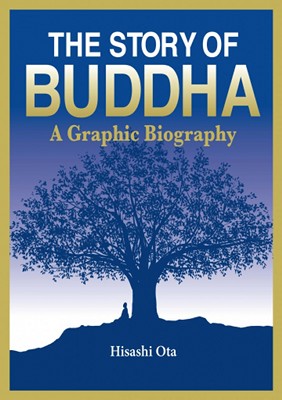
The Story of Buddha A Graphic Biography book cover
Money, power, and beautiful women, three desires of countless men throughout the ages. Imagine a man who has all three. A charmed life indeed, promising years of comfort and pleasure, yet he finds nothing but emptiness. He rejects this life to pursue one of meaning and purpose, and after great struggle, he finds true happiness and enlightenment. Of course, this is the story of no ordinary man, but that of Buddha, the legendary spiritual leader whose teachings have been passed on for thousands of years.
In The Story of Buddha A Graphic Biography (Ichimannendo Publishing, Inc., $10.95) Hisashi Ota tells of Buddha’s life through manga (Japanese comics) in a 248-page softcover book filled with comic panels. Focusing on Buddha’s transformation from the wealthy Prince Siddhartha to a spiritual teacher, I found myself drawn into a world paralleling modern day pressures: opportunities to escape reality and the expectation to live a typical life set by societal norms.
I enjoyed following the story through the expressive faces of the author’s characters, and I especially felt Siddhartha’s struggle to stay true to his own chosen path of life. Chapters end with Siddhartha’s insights, seeds that later blossom into the tenets of Buddhism. It was engaging to learn about Buddhism through the progressive rhythm of a narrative story with stylized visuals instead of a dry historic text.
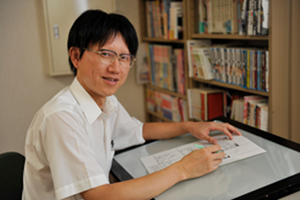
Hisashi Ota, author, The Story of Buddha A Graphic Biography
Ota poured feeling, action, and passion into each page. The story felt like a mirror to reflect upon modern life. Ota’s book pulses in the present, not the historic past, introducing Buddha’s teachings to audiences new and old, perhaps inspiring others to find joy and meaning in life.
I found Ota’s manga approach to Buddha’s story appealing because of the art form’s cinematic visual style. Ota, a graduate of Nagoya University’s School of Science, has been drawing manga for 20 years and his manga about Buddhism in Japan has been published regularly. Born a Buddhist, to this day Ota continues his training at the Jodo Shinshu Shinrankai Buddhist center in Toyama, Japan.
Photos: Tetsuji Yamamoto, Ichimannendo Publishing, Inc.
by Editor | Jan 3, 2012 | Books
By Joan Leacock
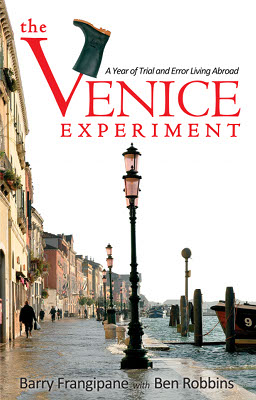
The Venice Experiment book cover
Photos: News & Experts
In this book, the author shared the story of how he quit the rat race of Florida in the United States to live as a resident of Venice, Italy. He and his wife took a year long journey, a cultural exchange from their lifestyle and expectations, and threw themselves at the mercy of living and being Venetians, experiencing the oddities of being foreigners abroad.
Having visited Venice many years ago and only vaguely remembering taking gondola rides up the Grand Canal, I found myself easily transported to the squares, bridges and streets of Venice and imagining all the characters mentioned in the book, as easily as if they were long lost friends. The Venice Experiment: A year of trial and error living abroad (Savory Adventures Publishing 2011, $14.95), a 238-page book by Barry Frangipane with Ben Robbins, captures the flavors, smells, warmth and frustrations of the year he and his wife spent living in The Floating City. I fell in love with Venice, through the eyes of the author, all over again.
Frangipane navigates the problems he encounters as a foreigner living abroad well. I laughed and moaned at the difficult situations he found himself in, as he and his wife fumbled their way through the narrow corridors of the Italian language, the city’s unique history and diverse personalities.

Barry Frangipane, author, The Venice Experiment
The book provides a concierge service of do’s and don’ts surrounding the legalities of moving to Venice. It became a fun expose of the complexities he experienced with language, assumptions and misinterpretations of cultural norms and, in particular, time management as he wondered at the beginning of their adventure, “Would I learn to see things from their perspective? Given a whole year to figure it out, how hard could it possibly be?”
Overall, I found this book to be an easy read with wonderful references to use and visit should I ever find myself in that part of the world. It is a quaint, funny and informal source of relevant information. The author provides a humorous induction of his move to this city, by cleverly disguising and exposing the red tape that he encountered. I was left with a comprehensive checklist of doable tasks in relation to the transferring of pets, visa requirements, how not to organize a lease for an apartment, the choice of ground floor versus first floor apartments, postal boxes, water taxis, vehicle parking and where to purchase everyday items in unexpected places.























